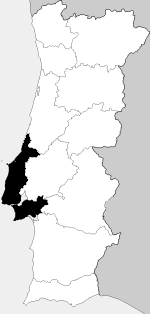Fort of Guincho
AlcabidecheBuildings and structures in CascaisCoastal fortifications in PortugalForts in PortugalProperties of Public Interest in Portugal

The Fort of Guincho, also known as the Fort of Velas, is located at the edge of the Praia do Abano, along the southern edge of the coast of the civil parish of Alcabideche, in Cascais Municipality, Lisbon District, Portugal.. It was classified as Property of Public Interest (Portuguese: Imóvel de Interesse Público) by the national government on 29 September 1977, but today stands in a state of decay, even after studies to remodel the location as a visitors centre for the nearby Sintra-Cascais Nature Park.
Excerpt from the Wikipedia article Fort of Guincho (License: CC BY-SA 3.0, Authors, Images).Fort of Guincho
Estrada do Abano,
Geographical coordinates (GPS) Address External links Nearby Places Show on map
Geographical coordinates (GPS)
| Latitude | Longitude |
|---|---|
| N 38.739891666667 ° | E -9.4732916666667 ° |
Address
Forte do Guincho (Forte do Abano)
Estrada do Abano
2750-070 (Alcabideche)
Portugal
Open on Google Maps










